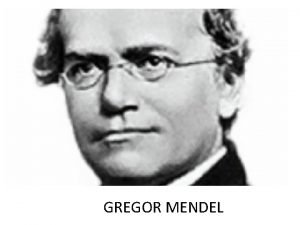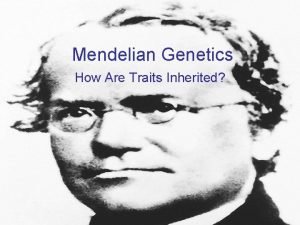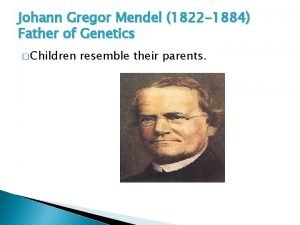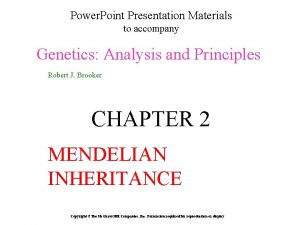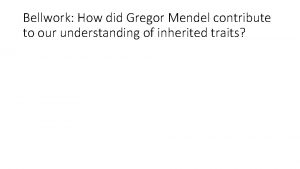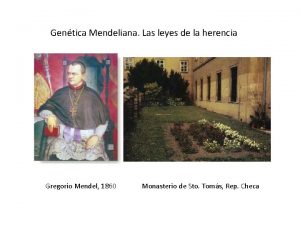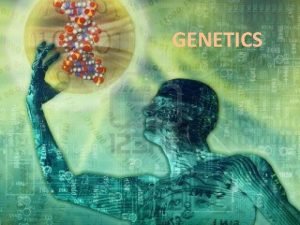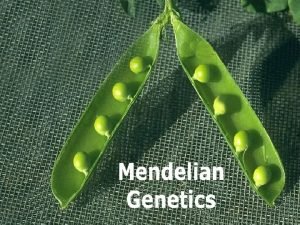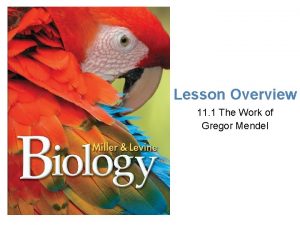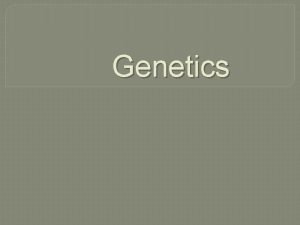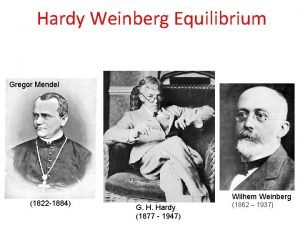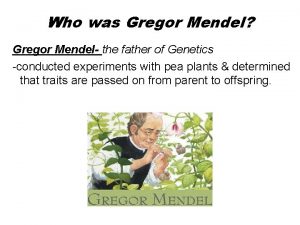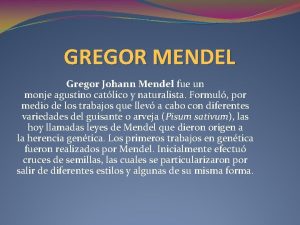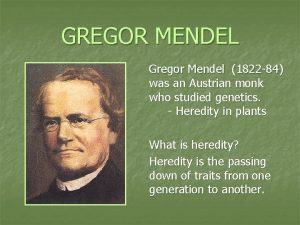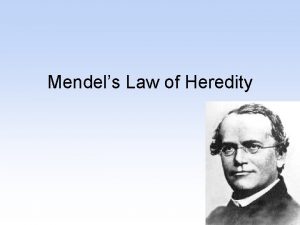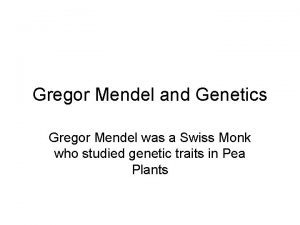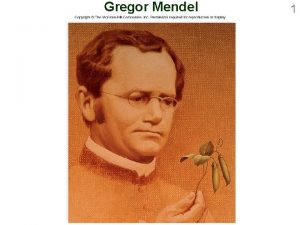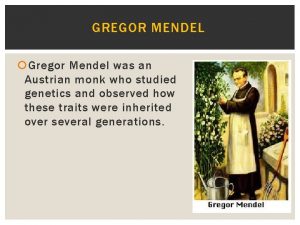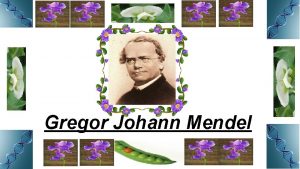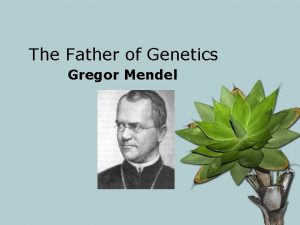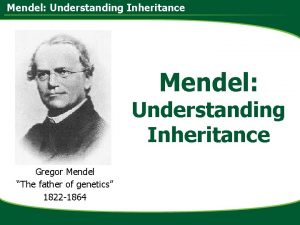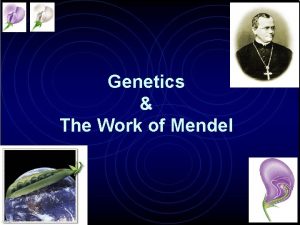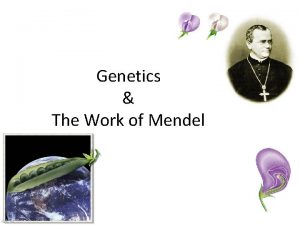11 1 The Work of Gregor Mendel Atwater

























- Slides: 25

11 -1 The Work of Gregor Mendel Atwater Agriculture Department

11 -1 Vocabulary l Genetics: – the scientific study of heredity You get your genetics from your ______, and ______ are examples of genetics.

Think Pair Share 1) What are genetics? 2) Where do you get your genetics from? Genetics are _______. We get our genetics from ____. Together, explain what a genetics are.

l True-breeding– term used to describe organisms that produce offspring identical to themselves if allowed to self-pollinate True-breeding happens in _____ when they self-pollinate.

Think Pair Share 1) What is true breeding? 2) What is an example of true breeding? True breeding is _______. An example of true breeding is ____. Together, explain what true breeding is.

l Trait– specific characteristic that varies from one individual to another – _____ would be a trait that your parents gave you.

Think Pair Share Sentence for Trait Definition for Trait Give one example Together, explain what a trait is and give an example.

11 -1 Vocabulary l Hybrid– offspring of crosses between parents with different traits A ____ is an example of a hybrid because _____.

l Gene– sequence of DNA that codes for protein and thus determines a trait – A gene codes for traits such as ______, _______ and _______.

l Allele– one of a number of different forms of a gene – An allele is a part of the chromosome

Think Pair Share 1) What is an allele? 2) Where alleles located at? An allele is _______. An allele can be found ____. Together, explain what an allele is.

11 -1 Vocabulary l Allele Segregation– separation of alleles during gamete formation l Segregation means _______.

Think Pair Share When does segregation happen? Segregation happens_______. Together, explain what segregation is.

l Gamete– specialized cell involved in sexual reproduction l Gamete is another word for _______ or _____ cells.

11 -1 Notes 1. Genes and Dominance a. Mendel studied different traits with contrasting characteristics b. Traits- a specific characteristic such as seed color or plant height that varies from one individual to another. c. Hybrids- Offspring of parent crosses with different traits d. Genes- chemical factors that determine traits (height) e. Alleles- different forms of a gene (short or tall)

11 -1 Notes f. Principle of dominance: Alleles can be dominant or recessive i. Dominant: trait is always seen Ii. Recessive: trait is seen if dominant is not present

Think Pair Share 1) What does Dominant mean? 2) What does recessive mean? Dominant means_____ Recessive means ____. Together, compare and contrast dominant and recessive traits.

11 -1 Notes 2. Explaining the F 1 Cross a. Segregationseparation of alleles b. Gametes- sex cells (during formation plant alleles were segregated) c. Law of Segregation: Alleles for each trait are randomly separated during formation of sex cells (gametes)

Principles of Dominance Section 11 -1 P Generation Tall Go to Section: Short F 1 Generation Tall F 2 Generation Tall Short

Principles of Dominance Section 11 -1 P Generation Tall Go to Section: Short F 1 Generation Tall F 2 Generation Tall Short

Principles of Dominance Section 11 -1 P Generation Tall Go to Section: Short F 1 Generation Tall F 2 Generation Tall Short

Figure 11 -3 Mendel’s Seven F 1 Crosses on Pea Plants Section 11 -1 Go to Section: Seed Shape Seed Color Round Yellow Seed Coat Color Gray Pod Shape Pod Color Flower Position Smooth Green Axial Tall Short Wrinkled Green White Constricted Yellow Terminal Round Yellow Gray Smooth Green Axial Plant Height Tall

11 -1 Review l What are dominant and recessive alleles? – Dominant allele: allele whose from of a trait always show up in an organism if the dominant allele is present – Recessive allele: allele whose form of a trait shows up only when the dominant allele is not present.

11 -1 Review l What is segregation? What happens to alleles during segregation? – Separation of paired alleles; the alleles are separated during the formation of gametes, with the result that each gamete carries only a single allele from the original pair. l What did Mendel conclude determines biological inheritance? – Factors that are passed from one generation to the next.

11 -1 Review l Describe how Mendel cross pollinated pea plants. . – Mendel cut away the male parts of one flower, then dusted it with pollen from another flower. l Why were true-breeding pea plants important for Mendel’s experiments? – True-breeding pea plants have two identical alleles for a gene, so in a genetic cross each parent contributed only one from of a gene, making inheritance patterns more detectable
 The work of gregor mendel lesson 1 chapter 12
The work of gregor mendel lesson 1 chapter 12 Chapter 11 the work of gregor mendel
Chapter 11 the work of gregor mendel Section 11–1 the work of gregor mendel
Section 11–1 the work of gregor mendel Chapter 12 lesson 1 the work of gregor mendel
Chapter 12 lesson 1 the work of gregor mendel How many pairs of chromosomes do humans have? *
How many pairs of chromosomes do humans have? * Gregor mendel
Gregor mendel Gregor mendel
Gregor mendel Who is gregor mendel
Who is gregor mendel Gregor mendel
Gregor mendel Generacion filial
Generacion filial Gregor mendel
Gregor mendel Gregor mendel laws
Gregor mendel laws Who is gregor mendel
Who is gregor mendel How did gregor mendel contribute to genetics
How did gregor mendel contribute to genetics Gregor mendel herencia
Gregor mendel herencia Gregor mendel conclusions
Gregor mendel conclusions Gregor mendel
Gregor mendel Austrian monk gregor mendel
Austrian monk gregor mendel Gregor mendel father of genetics
Gregor mendel father of genetics Gregor mendel summary
Gregor mendel summary Gregor mendel
Gregor mendel What did gregor mendel research
What did gregor mendel research Hardy weinberg equilibrium
Hardy weinberg equilibrium Tesztelő keresztezés
Tesztelő keresztezés Who is gregor mendel and what did he do?
Who is gregor mendel and what did he do? 11-2 probability and punnett squares answer key
11-2 probability and punnett squares answer key






